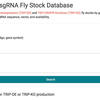CRISPR gRNA design
2018
Apr
13
The TRiP is now taking nominations for CRISPR stocks
. 10/11/2016. “FlyRNAi.org—the database of the Drosophila RNAi screening center and transgenic RNAi project: 2017 update.” Nucleic Acids Research. Publisher's VersionAbstract
. 10/31/2016. “Loss-of-function genetic tools for animal models: cross-species and cross-platform differences.” Nat Rev Genet. Publisher's VersionAbstract
. 2014. “Cas9-based genome editing in Drosophila.” Methods Enzymol, 546, Pp. 415-39.Abstract
. 2016. “CRISPR guide RNA design for research applications.” FEBS J.Abstract
. 2013. “Optimized gene editing technology for Drosophila melanogaster using germ line-specific Cas9.” Proc Natl Acad Sci U S A, 110, 47, Pp. 19012-7.Abstract


